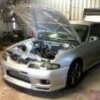Gtr To Come Back To "v8sc"
Announcements
-
Similar Content
-
Latest Posts
-
Fixed....LOL Sorry 🤪
-
Sadly we have something in common, our Skyline's like blowing up electrically 😢
-
So, no videos, but, the FAB9 Elite manifold and 68mm Bosch throttle bodies are in stock, but, not the rear part of the air box The FAB9 rear airbox thingie is made with a 3" intake pipe, to suit the 3" intake pipe size of a 68mm throttle body When they get some more in stock is currently unknown as I'm waiting for FAB9 to reply with a ETA on resupply, my assumption is they outsource their plastic printing stuff to "china", and with the current "tariff war" going on in 'Merica it could be on hold for an undisclosed time Should I pull the pin on the Intake and throttle body, and wait for the airbox?????, that's what I'm thinking... 1. Would the standard 2.75" OEM intake on the air box really be that much of a restriction compared to the 3" naturally aspirated?????? 2. If I don't get the 3" FAB9 airbox fitted at the same time as the intake and throttle body will it need a retune, when/if it eventually turns up?????? As I'm impulsive, to a fault, decisions will be made within....."what's the time now"???....let's say 12 hours......LOL
-
yeah its just so expensive nowadays and its easy to lose motivation very quickly when you start adding up the costs. I acquired the car from a collector in Melbourne and was lucky to get the opportunity to buy something already completed. I looked at a proper resto and your paying over 300-400K for a proper one (nut and bolt) so this one to me seemed like a much better option! Car is in private storage and for serious buyers, welcome to come see it/drive it in person (photos don't do it justice).
-
nice to see a proper resto, instead of the usual half arsed attempts where the owners wont even replace crappy floor mats
-











Recommended Posts
Create an account or sign in to comment
You need to be a member in order to leave a comment
Create an account
Sign up for a new account in our community. It's easy!
Register a new accountSign in
Already have an account? Sign in here.
Sign In Now